Do Green Neon Tetra Fish Need Special Lighting to Maintain Their Color? The Complete Illumination Guide
This post may contain affiliate links.
Green neon tetras are renowned for their spectacular iridescent coloration that seems to glow under aquarium lights. However, many aquarists wonder: do green neon tetra fish need special lighting to maintain their color? The answer involves understanding their natural habitat, the science of fish coloration, and how proper lighting can enhance or diminish their vibrant appearance. This comprehensive guide explores everything you need to know about lighting requirements for maintaining brilliant green neon tetra colors.
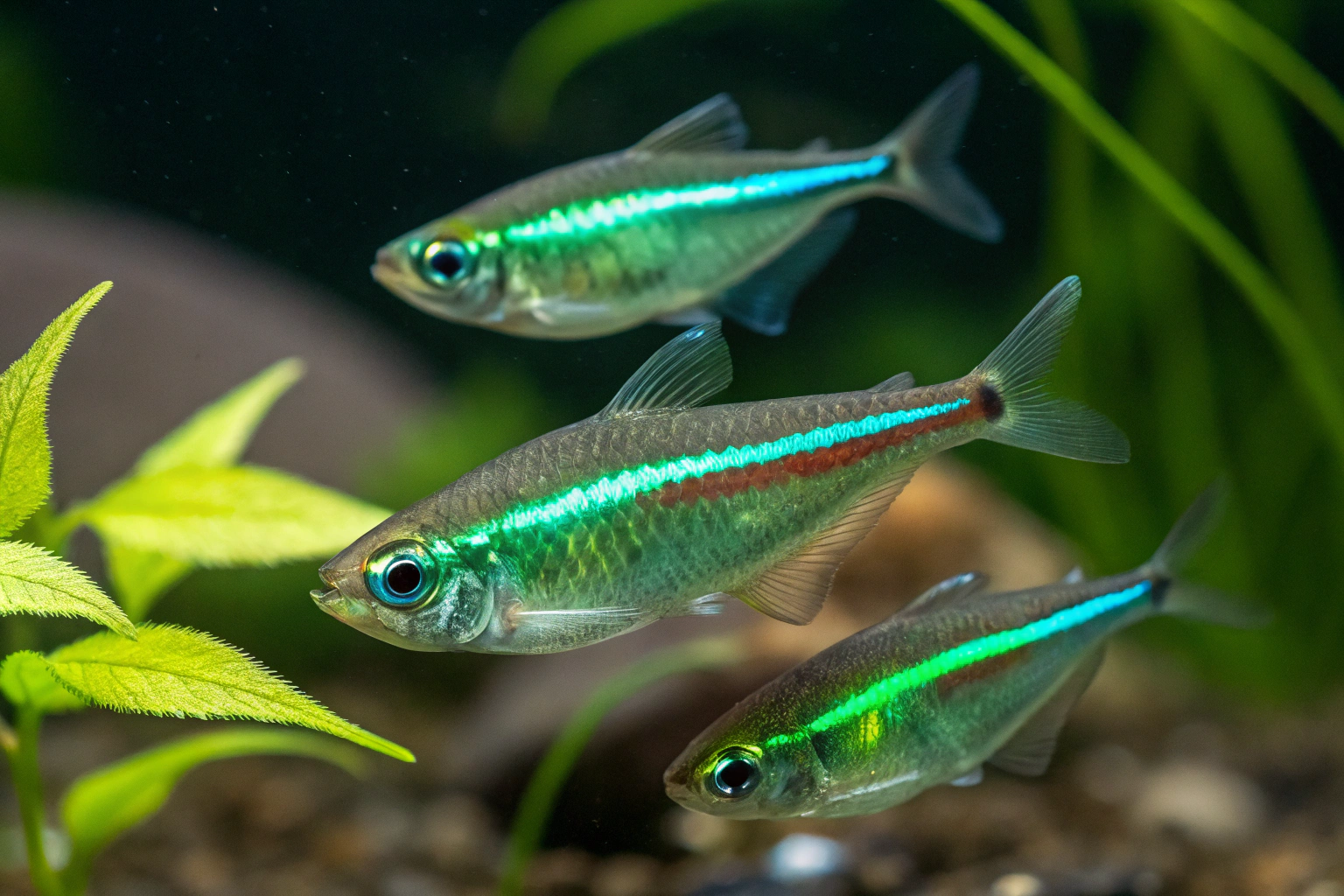
Understanding Green Neon Tetra Natural Coloration
Green neon tetras (Paracheirodon simulans) possess one of nature’s most remarkable color displays through specialized cells called iridophores and chromatophores. These microscopic structures contain reflective platelets and pigments that create their signature metallic green body stripe and electric blue lateral line.
The Science Behind Their Colors
Iridophores: These cells contain guanine crystals that reflect light, creating the metallic shimmer effect that makes green neon tetras appear to glow.
Chromatophores: Pigment-containing cells that produce the base green and blue colors through selective light absorption and reflection.
Structural Coloration: Unlike pigment-based colors, much of their brilliance comes from microscopic structures that interfere with light waves, similar to how soap bubbles create rainbow effects.
Natural Habitat Lighting Conditions
In their native Amazon River tributaries, green neon tetras experience specific lighting conditions that influence their color development and maintenance:
Amazonian Light Characteristics:
- Filtered sunlight: Heavy canopy coverage creates dappled, diffused lighting
- Spectral composition: Green-heavy spectrum due to plant filtration
- Variable intensity: Changing light levels throughout the day
- Tannin-stained water: Creates amber-tinted, soft lighting conditions
Understanding these natural conditions helps explain why certain aquarium lighting enhances their colors while others may cause them to appear washed out or stressed.
The Impact of Lighting on Green Neon Tetra Coloration
How Light Affects Color Display
Spectral Response: Green neon tetras’ iridescent scales respond differently to various light wavelengths. Research in aquarium lighting shows that specific color temperatures can dramatically enhance or diminish their natural brilliance.
Stress-Related Color Loss: Poor lighting conditions trigger stress responses that cause chromatophores to contract, resulting in faded, dull appearance.
Circadian Rhythm Impact: Proper lighting cycles influence hormonal balance, which directly affects color intensity and overall fish health.
Optimal Lighting Specifications for Green Neon Tetras
Color Temperature Requirements
Ideal Range: 6500K-7000K (Daylight spectrum)
- Enhances both green and blue coloration
- Mimics filtered tropical sunlight
- Supports healthy plant growth in planted tanks
Avoid: Cool white (>8000K) or warm white (<5000K)
- Cool white washes out green tones
- Warm white diminishes blue iridescence
Light Intensity Guidelines
Moderate Intensity: 20-40 PAR (Photosynthetically Active Radiation) at substrate level
- Provides adequate illumination without stress
- Supports live plant growth
- Maintains natural color vibrancy
Lighting Duration: 8-10 hours daily
- Consistent photoperiod prevents stress
- Allows for natural circadian rhythms
- Prevents algae overgrowth
Best Lighting Types for Green Neon Tetra Color Enhancement
LED Lighting Systems
Full-Spectrum LEDs offer the most versatile and effective lighting for green neon tetras:
Advantages:
- Customizable spectrum control
- Energy efficiency
- Long lifespan (50,000+ hours)
- Reduced heat production
Recommended Specifications:
- RGB+White chip combinations
- Adjustable color temperature (6500K-7000K)
- Dimming capabilities for sunrise/sunset effects
Professional aquarium LED reviews consistently rank full-spectrum systems as optimal for tetra coloration.
Fluorescent Lighting
T5 High Output (HO) fluorescent tubes remain popular for tetra tanks:
Best Tube Combinations:
- 6500K daylight tubes paired with plant-specific bulbs
- Full-spectrum aquarium bulbs designed for fish coloration
- Avoid basic cool white or warm white tubes
Metal Halide Systems
High-Intensity Options for larger, deeper tanks:
- Excellent color rendition
- Natural shimmer effects
- Higher heat production requires cooling
- More expensive operational costs
Lighting Features That Enhance Green Neon Tetra Colors
Programmable Controllers
Advanced LED Controllers allow precise spectrum and intensity adjustments:
Color Enhancement Features:
- Custom color mixing ratios
- Gradual sunrise/sunset transitions
- Storm simulation for natural behavior
- Moonlight phases for nocturnal observation
Reflector Systems
Quality Reflectors maximize light efficiency and distribution:
- Polished aluminum or silver-backed reflectors
- Parabolic designs for even light spread
- Reduces shadows and dark spots
Aquarium lighting design guides emphasize proper reflector selection for optimal fish coloration.
Signs of Proper vs. Poor Lighting
Indicators of Optimal Lighting:
Vibrant Coloration:
- Brilliant metallic green body stripe
- Electric blue lateral line clearly visible
- Overall fish appears to “glow” under lights
- Colors remain consistent throughout the day
Natural Behavior:
- Active swimming in open areas
- Normal schooling behavior
- Regular feeding responses
- Comfortable exploration of entire tank
Warning Signs of Poor Lighting:
Color Deterioration:
- Faded or dull green coloration
- Barely visible blue stripe
- Overall washed-out appearance
- Fish appear stressed or pale
Behavioral Changes:
- Excessive hiding behavior
- Reduced activity levels
- Poor appetite
- Abnormal schooling patterns
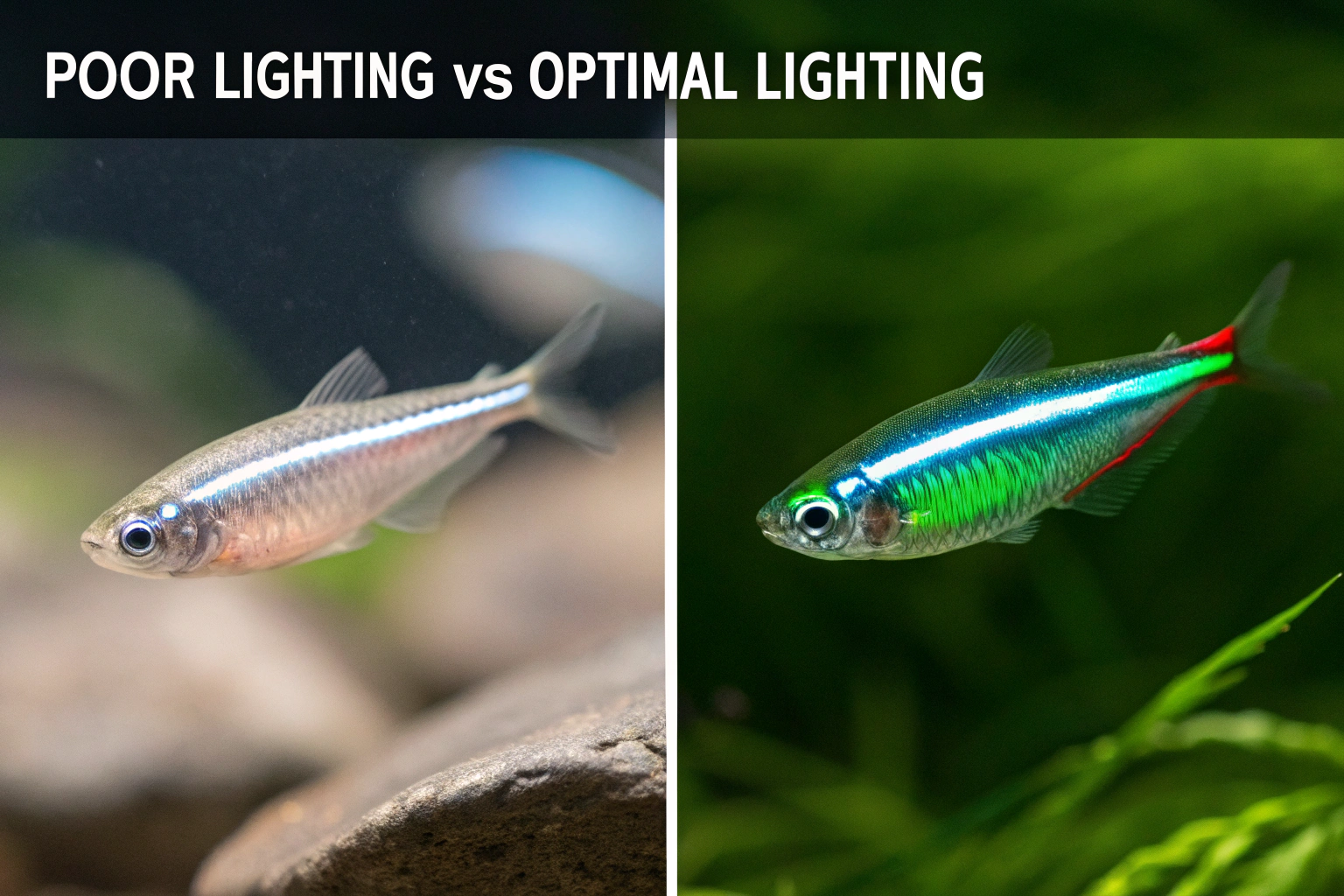
Lighting Setup for Different Tank Configurations
Planted Tank Lighting
Balanced Requirements: Green neon tetras in planted tanks benefit from lighting that serves both fish coloration and plant growth:
Recommended Setup:
- Full-spectrum LED systems (6500K-7000K)
- 30-50 PAR for moderate light plants
- 10-12 hour photoperiod with gradual transitions
- CO2 supplementation for optimal plant health
Species-Only Tank Lighting
Fish-Focused Illumination: Tanks dedicated to green neon tetras can optimize lighting specifically for color enhancement:
Optimal Configuration:
- Adjustable spectrum LEDs
- Lower overall intensity (20-30 PAR)
- 8-10 hour photoperiod
- Emphasis on green/blue spectrum enhancement
Community Tank Considerations
Multi-Species Compatibility: Community tank lighting guides recommend balanced approaches that enhance all species’ coloration without favoring one over others.
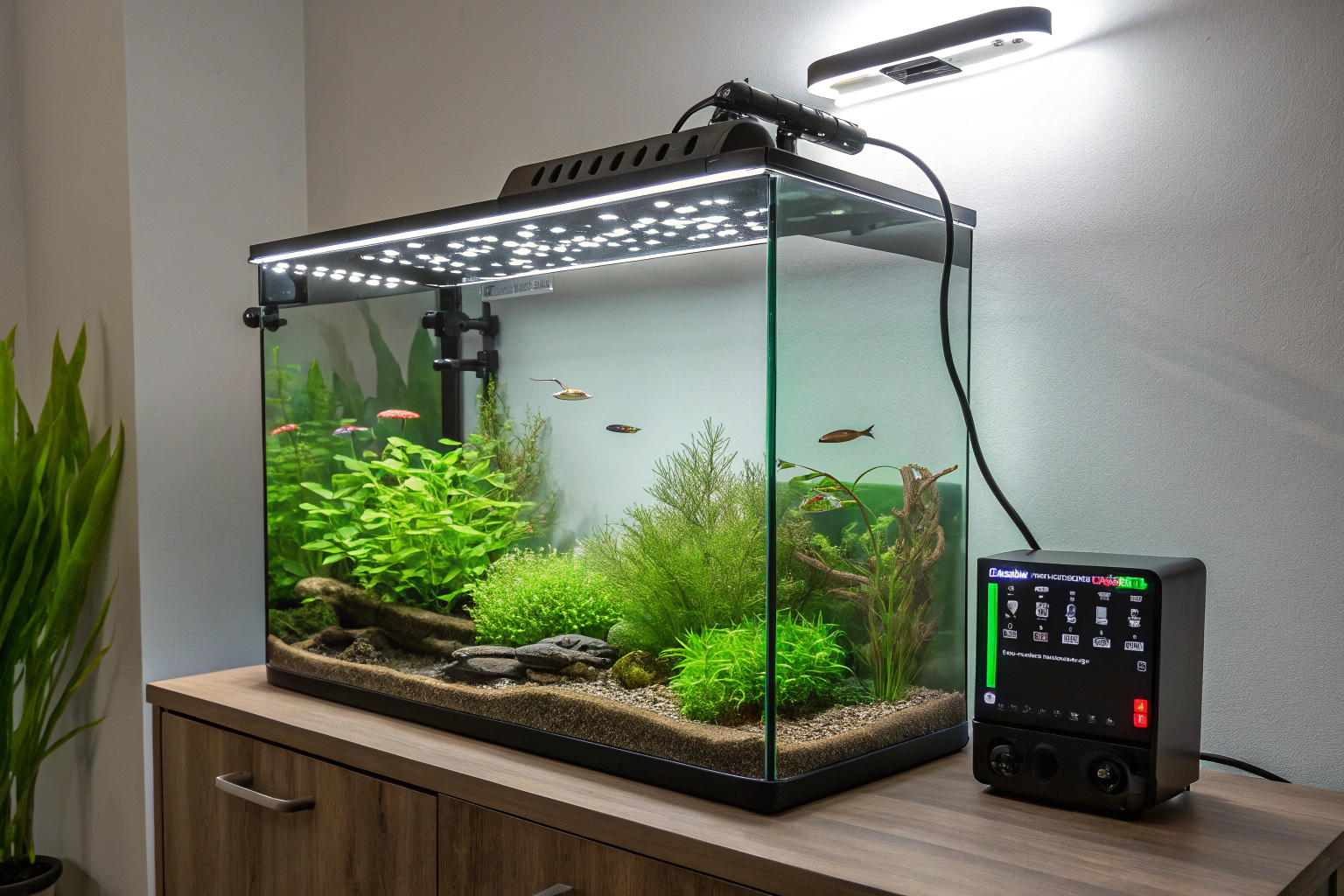
Seasonal Lighting Adjustments
Mimicking Natural Cycles
Dry Season Simulation (Higher intensity, longer photoperiod):
- Encourages breeding behavior
- Enhances territorial displays
- Stimulates natural activity patterns
Wet Season Simulation (Lower intensity, shorter photoperiod):
- Provides rest periods
- Reduces stress levels
- Maintains long-term health
Budget-Friendly Lighting Solutions
Entry-Level Options
Basic LED Strip Lights:
- Affordable full-spectrum options
- Suitable for smaller tanks (10-20 gallons)
- Fixed color temperature (6500K recommended)
- Manual timer controls
Fluorescent Alternatives:
- T8 or T5 fixtures with quality bulbs
- Lower initial cost than premium LEDs
- Regular bulb replacement required
- Limited spectrum control
Mid-Range Systems
Programmable LED Fixtures:
- App-controlled spectrum adjustment
- Pre-programmed fish enhancement modes
- Gradual lighting transitions
- 3-5 year warranties
Budget aquarium lighting comparisons provide detailed cost-benefit analyses for different price ranges.
Advanced Lighting Techniques
Color-Specific Enhancement
Red/Green Ratio Optimization: Fine-tuning red and green LED ratios can dramatically enhance the metallic green appearance of neon tetras.
Blue Channel Adjustment: Increasing blue spectrum intensity (440-460nm) enhances the electric blue lateral stripe visibility.
Dynamic Lighting Programs
Weather Simulation: Advanced aquarium automation includes storm patterns, cloud cover effects, and seasonal variations that promote natural behavior and coloration.
Breeding Enhancement: Specific lighting programs can trigger spawning behavior and enhance breeding coloration in green neon tetras.
Common Lighting Mistakes That Affect Coloration
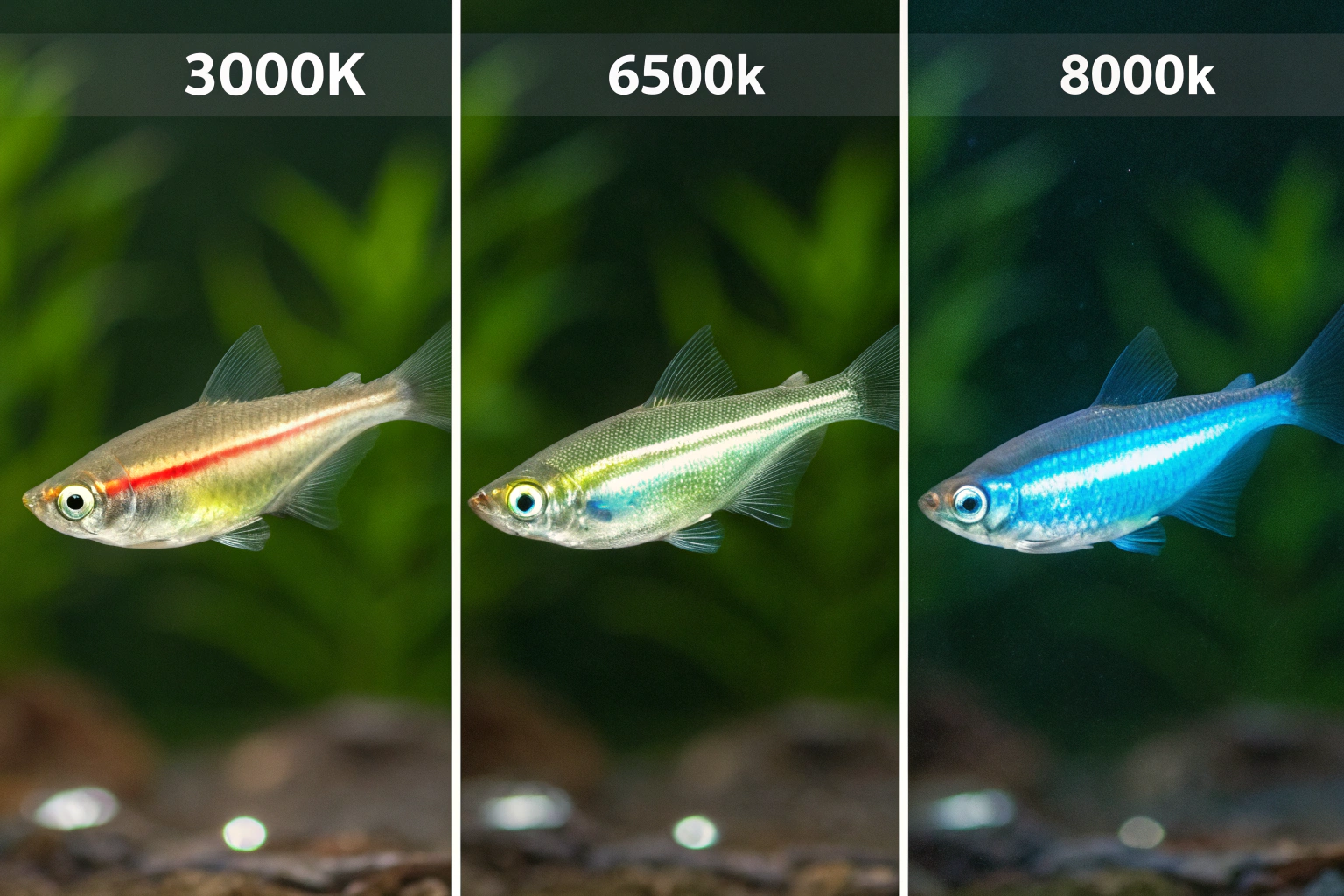
Excessive Intensity
Overillumination Problems:
- Washed-out fish colors
- Increased stress levels
- Algae growth issues
- Higher electricity costs
Poor Spectrum Selection
Cool White LEDs: Common in cheap fixtures, these wash out green and blue tones, making fish appear dull and lifeless.
Inconsistent Photoperiods: Irregular lighting schedules disrupt circadian rhythms and negatively impact coloration.
Inadequate Coverage
Hot Spots and Shadows: Uneven light distribution creates areas where fish colors appear different, indicating poor fixture placement or inadequate coverage.
Maintenance and Longevity Considerations
LED Lifespan and Performance
Color Shift Over Time: LEDs gradually shift spectrum as they age, potentially affecting fish coloration after 3-5 years of operation.
Cleaning Requirements: Dust and mineral deposits on LED lenses reduce light output and alter spectrum delivery.
Replacement Schedules
Fluorescent Bulbs: Replace every 10-12 months for optimal spectrum output LED Fixtures: Monitor for color shifts after 40,000+ hours of operation
Aquarium maintenance schedules include lighting system care guidelines for long-term performance.
Health Benefits of Proper Lighting
Immune System Support
Circadian Rhythm Regulation: Consistent lighting cycles support hormonal balance and immune function, directly impacting the fish’s ability to maintain vibrant coloration.
Stress Reduction: Proper lighting reduces cortisol levels, allowing natural pigmentation systems to function optimally.
Breeding and Reproduction
Spawning Triggers: Seasonal lighting changes can stimulate breeding behavior, during which green neon tetras display their most intense coloration.
Fry Development: Young green neon tetras require specific lighting conditions for proper color development as they mature.
Water Chemistry and Lighting Interactions
pH Stability
Light-Induced pH Swings: In planted tanks, photosynthesis can cause daily pH fluctuations that stress fish and affect coloration. Water chemistry management guides address these interactions.
Algae Prevention
Balanced Lighting: Proper spectrum and duration prevent algae blooms that can cloud water and diminish light penetration, affecting fish color visibility.
Compatibility with Tank Equipment
Filter and Heater Placement
Light Penetration: Equipment positioning affects light distribution and can create shadows that impact color display uniformity.
CO2 System Integration
Planted Tank Considerations: CO2 injection systems work synergistically with proper lighting to maintain optimal water chemistry for green neon tetra coloration.
Photography and Observation Tips
Capturing True Colors
Camera Settings: Aquarium photography guides recommend specific lighting angles and camera settings to capture green neon tetra colors accurately.
Viewing Angles: Fish colors appear different from various angles due to iridescence effects. Position lighting to optimize viewing from your primary observation point.
Future Lighting Technology
Smart Lighting Systems
AI-Controlled Adjustments: Emerging technology includes systems that automatically adjust lighting based on fish behavior and coloration feedback.
Spectral Analysis: Advanced systems can analyze fish coloration in real-time and optimize lighting accordingly.
Environmental Impact and Efficiency
Energy Consumption
LED Advantages: Modern LED systems consume 75-80% less energy than traditional fluorescent setups while providing superior color enhancement.
Heat Reduction: Lower heat production reduces cooling costs and maintains stable water temperatures.
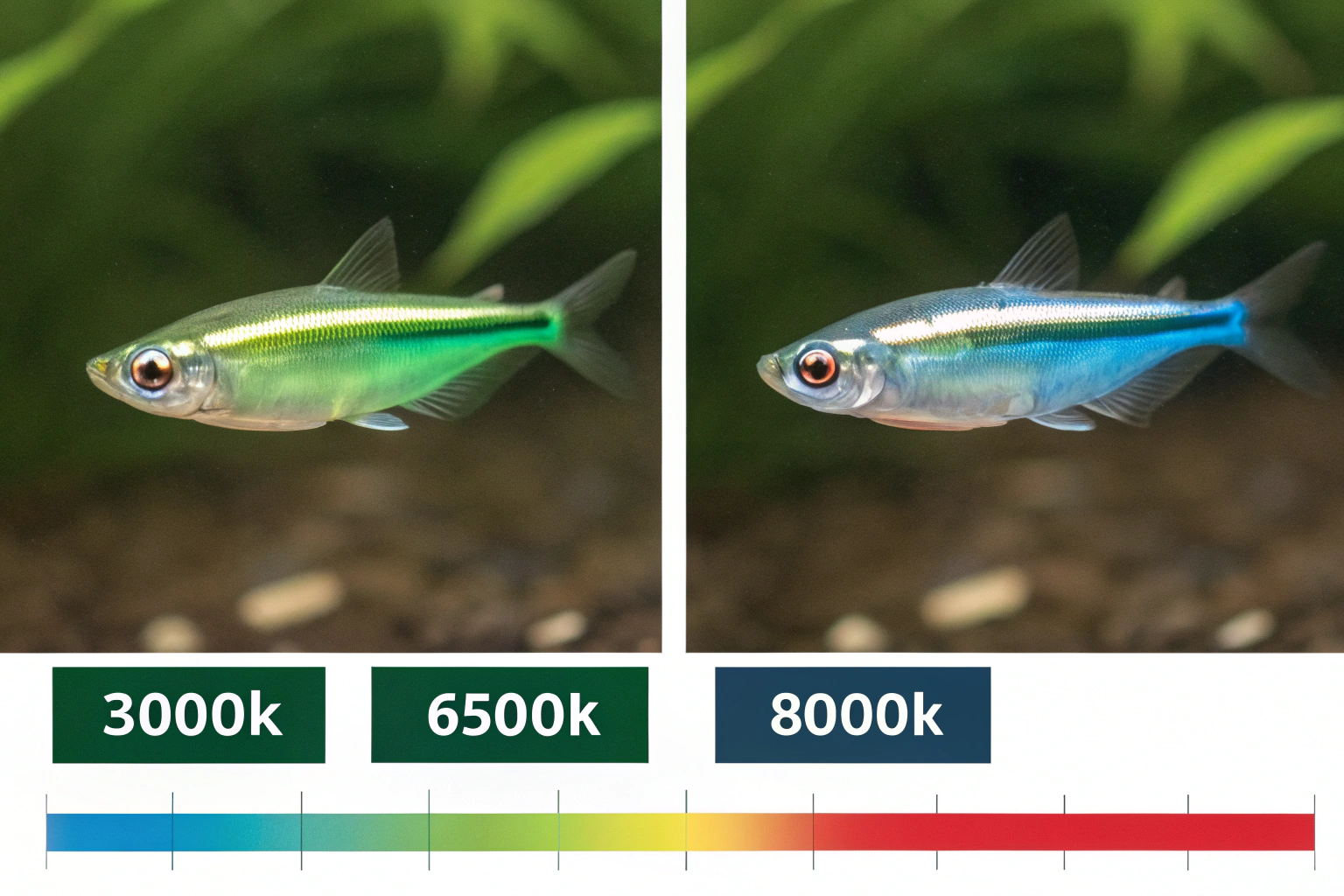
Conclusion: Optimizing Lighting for Spectacular Green Neon Tetra Colors
The question “do green neon tetra fish need special lighting to maintain their color?” has a definitive answer: Yes, proper lighting is crucial for maintaining and enhancing their spectacular coloration. While green neon tetras won’t lose their colors entirely under poor lighting, their brilliance and vibrancy depend significantly on appropriate spectrum, intensity, and photoperiod management.
The key factors for optimal green neon tetra coloration include:
- Spectrum: 6500K-7000K color temperature with full-spectrum coverage
- Intensity: Moderate lighting (20-40 PAR) that doesn’t cause stress
- Duration: Consistent 8-10 hour photoperiods with gradual transitions
- Quality: High-quality LED or fluorescent systems designed for aquarium use
Investing in proper lighting not only enhances the visual appeal of your green neon tetras but also supports their overall health, natural behavior, and longevity. The dramatic difference between fish kept under optimal versus suboptimal lighting conditions is immediately apparent to both novice and experienced aquarists.
Remember that lighting requirements may vary based on tank size, companion species, live plants, and individual fish responses. Consult with lighting specialists and monitor your fish closely to achieve the perfect balance that showcases these magnificent fish at their most brilliant.
With proper lighting, green neon tetras transform from simple aquarium fish into living jewels that create breathtaking displays rivaling any natural wonder. The investment in quality lighting pays dividends in the form of healthy, vibrantly colored fish that bring joy and amazement to every viewing experience.
For comprehensive aquarium lighting guides, product reviews, and expert consultation services, visit our complete lighting resource center and connect with fellow aquarists in our community lighting forums.
